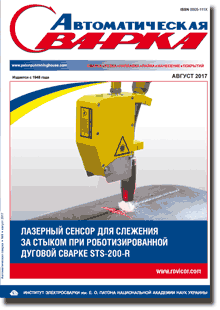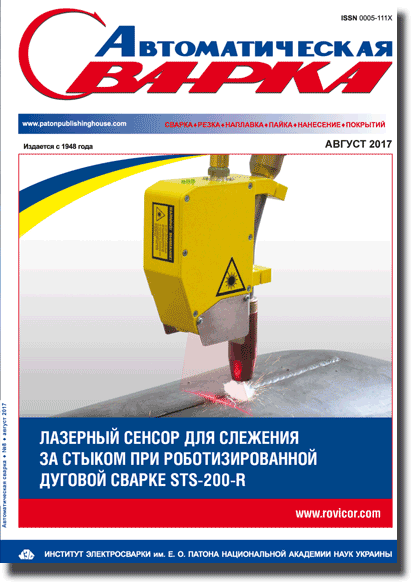| 2017 №08 (03) |
DOI of Article 10.15407/as2017.08.04 |
2017 №08 (05) |

Журнал «Автоматическая сварка», № 8, 2017, с. 29-36
Исследование процесса получения структуры и свойств магнетронных нанослойных FeAl-покрытий
Ю. С. Борисов1, М. В. Кузнецов1, Б. Т. Ткаченко1, А. В. Волос1, В. Г. Задоя1, Л. М. Капитанчук1, А. И. Гудыменко2, В. Ф. Горбань3
1ИЭС им. Е. О. Патона НАН Украины. 03680, г. Киев-150, ул. Казимира Малевича, 11. E-mail: office@paton.kiev.ua
2Ин-т физики полупроводников им. В. В. Лошкарева НАН Украины. 03028, г. Киев, просп. Науки, 45. E-mail: mickle@semicond.kiev.ua
3Институт проблем материаловедения им. И. Н. Францевича НАН Украины. 03142, Киев-142, ул. Акад. Кржижановского, 3. E-mail: post@ipms.kiev.ua
Реферат
Работа посвящена исследованию процесса формирования FeAl-покрытия с регулируемым составом на подложках из стали 08Х18Н10Т при совместном магнетронном распылении составной мишени Al + Fe с нагреваемой выше точки Кюри (768 ?С) вставкой из С т.3 и алюминиевой мишени. Применение системы цикличного перемещения подложки в активных зонах работы магнетронов позволило формировать нанослойную структуру покрытий с толщиной нанослоев Al — 1,3...1,9, Fe — 1,6 нм. Покрытия исследовали методами Оже-спектрометрии, рентгеновской дифракции и микроиндентирования. Установлено, что FeAl-покрытия толщиной 3 мкм, содержащие 39,6 и 54,6 ат. % Al, являются упорядоченной фазой В 2 — FeAl, состоящей из зерен размером 0,135...0,173 и 0,293...0,335 мкм, сформированных из нанокристаллитов размером 7 и 22 нм, соответственно. Библиогр. 17, табл. 4, рис. 6.
Ключевые слова: магнетронное распыление, нанослойная структура, FeAl-покрытия, регулируемый состав
Поступила в редакцию 13.06.2017
Список литературы
- Cinca N., Guilemany J. M. (2012) Thermal spraying of transition metal aluminides: An overview. Intermetallics, 24, 60–72.
- Cinca N., Guilemany J. M. (2013) An overview of intermetallics research and application: Status of thermal spray coatings. Journal of Materials Research and Technology, 2, 1, 1–11.
- Paldey S., Deevi S. C. (2003) Cathodic arc deposited FeAl coatings: properties and oxidation characteristics. Materials Science and Engineering, A355, 208–215.
- Arcon I., Mozetic M., Zalar A. et al. (2003) EXAFS study of ion beam mixed Fe/Al multilayers. Nuclear Instruments and Methods in Physics Research, B199, 222–226.
- Brajpuriya R., Tripathi S., Chaudhari S. M. (2005) Thermally induced changes in magnetic, transport and electronic properties Fe/Al multilayers. Solid State Communications, 134, 479–484.
- Levin A. A., Meyer D. C., Paufler P. (2000) Structural modifications of laser deposited Fe-Al multilayers due to thermal treatment. Journal of Alloys and Compounds, 297, 59–67.
- Levin A. A., Meyer D. C., Gorbunov A. et al. (2001) Comparative study of interfaces of Fe-Al multilayers prepared by direct and crossed-beam pulsed laser deposition. Thin Solid Films, 391, 47–56.
- Levin A. A., Meyer D. C., Paufler P. et al. (2001) Thermally stimulated solid state reactions in Fe-Al multilayers prepared by pulsed laser deposition. Journal of Alloys and Compounds, 320, 114–125.
- Paldey S., Deevi S. C.( 2003) Single layer and multilayer wear resistant coatings of (Ti, Al)N: a review. Materials Science and Engineering, A342, 58–79.
- Zhenya L., Wei G. (1998) Oxidation behaviour of FeAl intermetallic coatings produced by magnetron sputter deposition. Scripta Materialia, 39, 1497–1502.
- Sanchette F., Billard A. (2001) Main feature of magnetron sputtered aluminium-transition metal alloy coatings. Surf. and Coat.Technol., 142-144, 218–224.
- Cherif S.M., Boussigne K., Roussigne Y. (2007) Growth and magnetic study of sputtered Fe/Al multilayers. Materials Science and Engineering B, 138, 16–21.
- Марченко И. Г., Марченко И. И., Неклюдов И. М. (2004) Компьютерное моделирование вакуумного осаждения пленок ниобия. Вісник Харківського університету, 628, 93–98.
- Томаль В. С., Касинский Н. К., И ванов И. В. (2013) Воспроизводимость свойств оптических вакуумных покрытий. Материалы. Технологии. Инструменты, 18, 75–77.
- Игнатович С. Р., Закиев И. М. (2009) Универсальный микро-наноиндентометр «Микрон-гамма». Заводская лаборатория, 77, 1, 61–67.
- Горбань В. Ф., Закиев И. М., Саржан Г. Ф. (2016) Сравнительные характеристики трения высоэнтропийных мононитридных покрытий. Трение и износ, 37, 3, 340–344.
- Горбань В. Ф., Мамека Н. А., П ечковский Э. П., Фирсов С. А.( 2006) Индентификация структурного состояния материалов методом автоматического индентирования. Сб. докл. Харьковской нанотехнологической ассамблеи, 1, 52–55.
Читати реферат українською
Ю. С. Борисов1, М. В. Кузнецов1, Б. Т. Ткаченко1, О. В. Волос1, В. Г. Задоя1, Л. М. Капітанчук1, О. І. Гудименко2, В. Ф. Горбань3
1ІЕЗ ім. Є. О. Патона НАН України. 03680, м. Київ-150, вул. Казимира Малевича, 11. E-mail: office@paton.kiev.u 2Ін-т фізики напівпровідників ім. В. В. Лошкарева НАН України 03028, м. Київ, просп. Науки, 45. E-mail: mickle@semicond.kiev.ua 3Ін-т проблем матеріалознавства ім. І. М. Францевича НАН України 03142, м. Київ-142, вул. Акад. Кржижанівського, 3. E-mail: post@ipms.kiev.ua
Дослідження процесу отримання структури і властивостей магнетронних нанослойних FeAl-покриттів
Робота присвячена дослідженню процесу формування FeAl-покриття з регульованим складом на підкладках зі сталі 08Х18Н10Т при спільному магнетронному розпиленні складеної мішені Al + Fe з вставкою з С т.3, що нагрівається вище точки Кюрі (768 ?С) і алюмінієвої мішені. Застосування системи циклічного переміщення підкладки в активних зонах роботи магнетронів дозволило формувати нанослойну структуру покриття з товщиною наношарів Al — 1,3...1,9, Fe — 1,6 нм. Покриття досліджували методами Оже-спектрометрії, рентгенівської дифракції та мікроіндентування. Встановлено, що FeAl-покриття товщиною 3 мкм, що містять 39,6 і 54,6 ат. % Al, є впорядкованою фазою В2–FeAl, що складається з зенанокристалітів розміром 7 і 22 нм, відповідно. Бібліогр. 17, табл. 4, рис. 6.
Ключові слова: магнетронне розпилення, нанослойна структура, FeAl-покриття, регульований склад
Read abstract and references in English
Yu. S. Borisov1, M. V. Kuznetsov1, B. T. Tkachenko1, A. V. Volos1, V. G. Zadoya1, L. M. Kapitanchuk1, A. I. Gudymenko2, V. F. Gorban3
1E. O. Paton Electric Welding Institute of the NASU. 11 Kazimir Malevich str., Kiev-150, 03680. E-mail:office@paton.kiev.ua 2V. E. Lashkaryov Institute of Semiconductor Physics of the NAS of Ukraine. 45 Nauki ave., Kiev, 03028. E-mail: mickle@semicond.kiev.ua 3I. M. Frantsevich Institute of Problems of Materials Science of the NAS of Ukraine. 3 Akad. Krzhizhanovski, Kiev-142, 03142.
E-mail: post@ipms.kiev.ua
INVESTIGATION OF PROCESS OF FORMATION OF STRUCTURE AND PROPERTIES OF MAGNETRON NANOLAYER FeAl-COATINGS
The work is dedicated to investigation of process of formation of Fe-Al coating with regulated composition on substrates of 08Kh18N10T steel at mutual magnetron sputtering of composite target Al + Fe with heated above the Curie point (768 °C) insert of St.3 and aluminum target. Application a system of cyclic substrate movement in active zones of magnetron operation allowed forming nanolayer structure of coating with Al – 1.3 and Fe – 1.6 nm nanolayer thickness. The coatings were investigated using Auger spectrometry, X-ray diffraction and microindentation. It is determined that 3 ?m FeAl-coating containing 39.6 and 54.6 at.% of Al are ordered B2 – FeAl phase consisting of 0.135-0.173 and 0.293 – 0.335 ?m size grains, formed from nanocrystallites of 7 and 22 nm, respectively. 17 Ref., 4 Tables, 6 Figures.
Keywords: magnetron sputtering, nanolayer structure, FeAlcoating, regulated laye
References
- Cinca, N., Guilemany, J.M. (2012) Thermal spraying of transition metal aluminides: An overview. Intermetallics, 24, 60-72.
- Cinca, N., Guilemany, J.M. (2013) An overview of intermetallics research and application: Status of thermal spray coatings. J. of Materials Research and Technology, 2(1), 1-11.
- Paldey, S., Deevi, S.C. (2003) Cathodic arc deposited FeAl coatings: Properties and oxidation characteristics. Mater. Sci & Engin., A355, 208-215.
- Arcon, I., Mozetic, M., Zalar, A. et al. (2003) EXAFS study of ion beam mixed Fe/Al multilayers. Nuclear Instruments and Methods in Physics Research, B199, 222-226.
- Brajpuriya, R., Tripathi, S., Chaudhari, S.M. (2005) Thermally induced changes in magnetic, transport and electronic properties Fe/Al multilayers. Solid State Communications, 134, 479-484.
- Levin, A.A., Meyer, D.C., Paufler, P. (2000) Structural modifications of laser deposited Fe-Al multilayers due to thermal treatment. J. of Alloys and Compounds, 297, 59-67.
- Levin, A.A., Meyer, D.C., Gorbunov, A. et al. (2001) Comparative study of interfaces of Fe-Al multilayers prepared by direct and crossed-beam pulsed laser deposition. Thin Solid Films, 391, 47-56.
- Levin, A.A., Meyer, D.C., Paufler, P. et al. (2001) Thermally stimulated solid state reactions in Fe-Al multilayers prepared by pulsed laser deposition. J. of Alloys and Compounds, 320, 114-125.
- Paldey, S., Deevi, S.C. (2003) Single layer and multilayer wear resistant coatings of (Ti, Al)N: A review. Mater. Sci. & Engin., A342, 58-79.
- Zhenya, L., Wei, G. (1998) Oxidation behaviour of FeAl intermetallic coatings produced by magnetron sputter deposition. Scripta Materialia, 39, 1497-1502.
- Sanchette, F., Billard, A. (2001) Main feature of magnetron sputtered aluminium-transition metal alloy coatings. Surf. and Coat. Technol., 142-144, 218-224.
- Cherif, S.M., Boussigne, K., Boussigne, Y. (2007) Growth and magnetic study of sputtered Fe/Al multilayers. Mater. Sci. & Engin., 138, 16-21.
- Marchenko, I.G., Marchenko, I.I., Neklyudov, I.M. (2004) Computer modeling of vacuum deposition of niobium films. Visnyk Kharkivskogo Universytetu, 628, 93-98.
- Tomal, V.S., Kasinsky, N.K., Ivanov, I.V. (2013) Repeatability of properties of optical vacuum coatings. Materialy. Tekhnologii. Instrumenty, 18, 75-77.
- Ignatovich, S.R., Zakiev, I.M. (2009) Universal micro-nanoindentometer Mikron-gamma. Zavod. Laboratoriya, 77(1), 61-67.
- Gorban, V.F., Zakiev, I.M., Sarzhan, G.F. (2016) Comparative characteristics of friction of high entropic mononitride coatings. Trenie i Iznos, 37(3), 340-344.
- Gorban, V.F., Mameka, N.A., Pechkovsky, E.P. et al. (2006) Indentification of structural state of materials by method of automatic indentation. In: Kharkovskaya Nanotekhnologicheskaya Assambleya: Transact., 1, 52-55.
Вартість передплати/замовлення на журнали або окремі статті
| журнал/валюта | річний комплект друкований |
1 прим. друкований |
1 прим. електронний |
одна стаття (pdf) |
| AS/UAH | 1800 грн. | 300 грн. | 300 грн. | 150 грн. |
| AS/USD | 192 $ | 32 $ | 26 $ | 13 $ |
| AS/EUR | 180 € | 30 € | 25 € | 12 € |
| TPWJ/UAH | 7200 грн. | 600 грн. | 600 грн. | 280 грн. |
| TPWJ/USD | 384 $ | 32 $ | 26 $ | 13 $ |
| TPWJ/EUR | 348 € | 29 € | 24 € | 12 € |
| SEM/UAH | 1200 грн. | 300 грн. | 300 грн. | 150 грн. |
| SEM/USD | 128 $ | 32 $ | 26 $ | 13 $ |
| SEM/EUR | 120 € | 30 € | 25 € | 12 € |
| TDNK/UAH | 1200 грн. | 300 грн. | 300 грн. | 150 грн. |
| TDNK/USD | 128 $ | 32 $ | 26 $ | 13 $ |
| TDNK/EUR | 120 € | 30 € | 25 € | 12 € |
AS = «Автоматическая сварка» - 6 накладів на рік;
TPWJ = «PATON WELDING JOURNAL» - 12 накладів на рік;
SEM = «Современная электрометаллургия» - 4 наклада на рік;
TDNK = «Техническая диагностика и неразрушающий контроль» - 4 наклада на рік.





